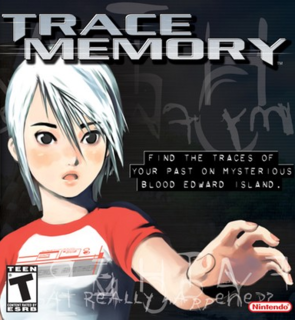Perfect example of how to use the DS hardware to make a fun and unique game.
Trace Memory begins with the main character, Ashley, heading to the ominous Blood Edward Island on the day before her fourteenth birthday to meet her father whom she thought was dead. With her aunt (Ashley's mother is also dead) and a mysterious device her father sent her, Ashley plans to meet up with her father. Got all of that? The previous is all learned in the introduction to the game and sets the tone for the rest of the adventure. As would be expected with an adventure game, in record time you find yourself wandering the island and attempting to solve the mysteries that surround it.
Solving the mysteries of Blood Edward Island is handily accomplished by running around the island using the bottom screen while the top screen is used to display various parts of the scenery. While this helps you to get a feel for what the environments look like (since the movement view is top down), it also detracts from some of the adventure since the scene on the top screen changes when you approach something to be investigated. When you investigate, the bottom screen is replaced with the scene and you can touch various items in it to receive more information, collect items, or start puzzles.
The puzzles in Trace Memory range from logic riddles to strange physical manipulations of the DS, but remain fun and fresh. The touch screen is used in all the puzzles from turning a crank to tossing an object. Unfortunately, some of the puzzles aren't obvious and the ones that require physical manipulation of the DS can be downright frustrating. Fortunately, the frustrating puzzles are few and far between and hardly detract from the rest of the game.
The story is both driving, inane, and slow. On the one hand you're interested in finding Ashley's father, learning more about what happened to her Mother, and finding more out about the history of Blood Edward Island. Once you do, however, the answers may leave you questioning the logic of the characters. In an adventure game, especially one such as this which attempts to be rich in plot and intrigue, you would think that the designers would take great care to fix any fallacies. Told mostly through long and linear dialogues, the story can also drag on to the point where you develop a crippling anti-social syndrome.
The graphics are good and the still scenes are well detailed and complimented by the music and sounds that round out the game.
For better or for worse, Trace Memory is a short game lasting between two and six hours, though this is feels like the right amount of time for the game. Though there is a reason to replay a second time, you may not want to in fear of having to read the copious dialogue.
Trace Memory puts great use to the unique DS hardware, making it feel like a game that needed to be on the DS rather than happened to land on it. It packs enough fun puzzles and interesting story points to justify at least giving it a try.

